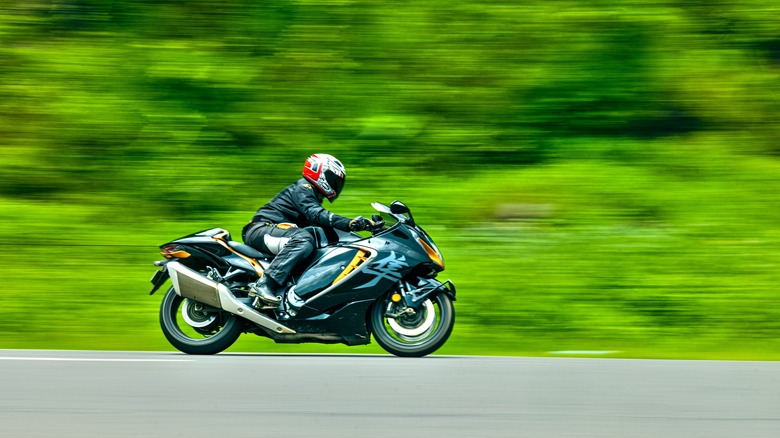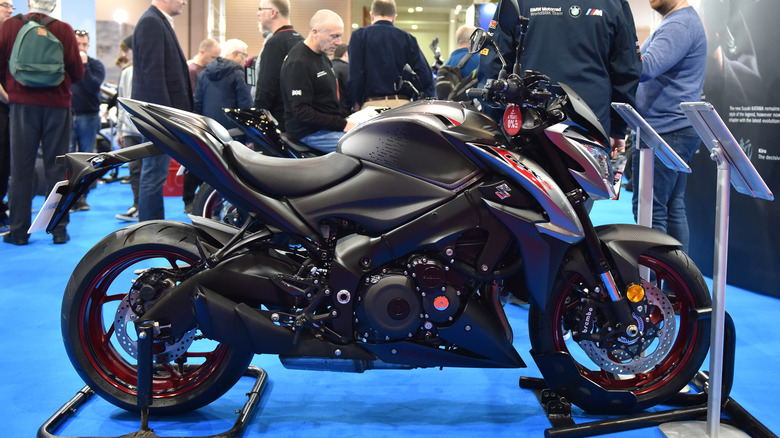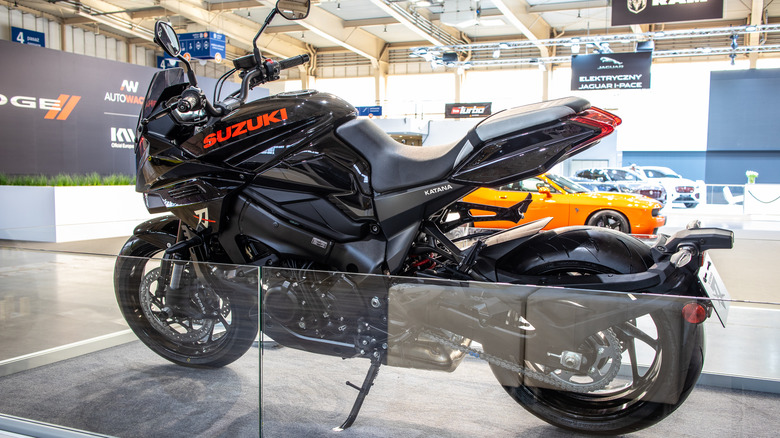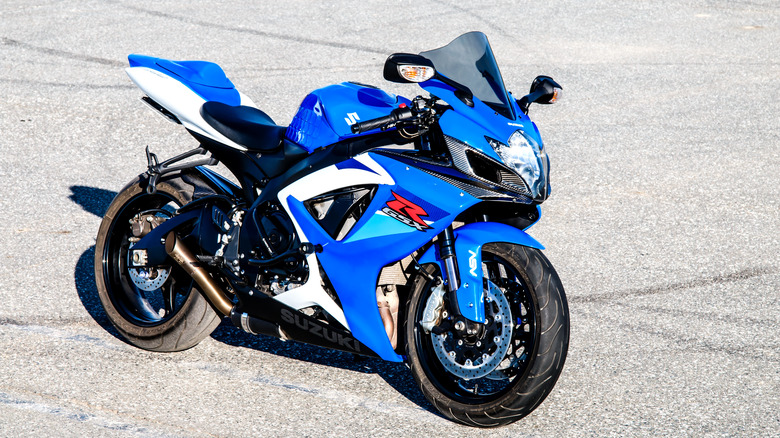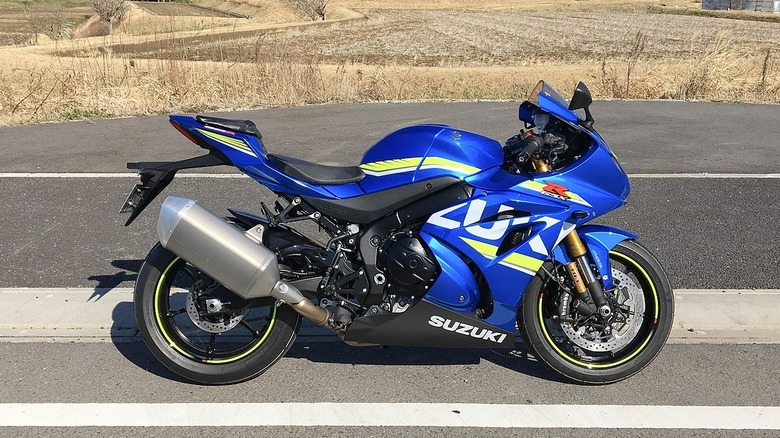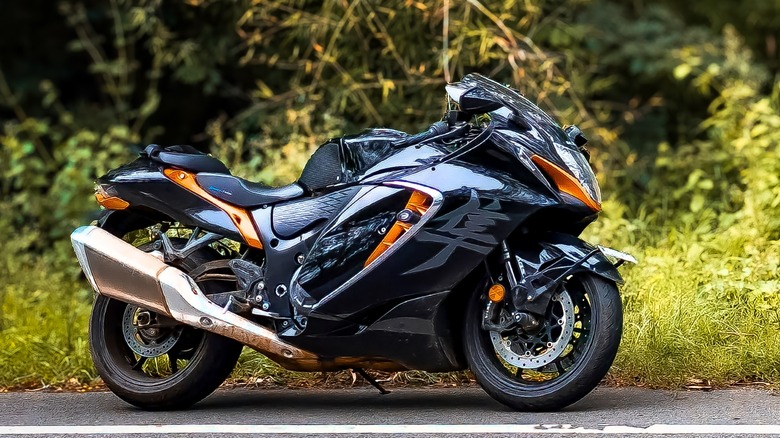5 Of The Fastest Suzuki Motorcycles Ever Built
Suzuki has had a long history of manufacturing motorcycles, cars, outboard marine motors, and more, going back to 1909. With all that experience, it has become a familiar brand worldwide, but it is probably best known for its lineup of motorcycles.
Suzuki has been on the championship racing circuit for decades with notable MotoGP world champions like the legendary Barry Sheen from the 1970s, Randy Mamola from the 1980s, and Kevin Schwantz from the 1990s. All that racing experience informed the design and engineering of the company's street-legal bikes, a few of which were — and are — some of the fastest in the world. The fastest ones are usually pretty expensive (for obvious reasons), but Suzuki has plenty of affordable options as well.
More recently, Suzuki has kept updating its motorcycles with the latest tech but has moved more into four-wheeler sales, mostly in India (a huge market). With that said, it has some high-speed motorcycles in its lineup, and a few stand out from the rest. Check out this list of five of the fastest Suzuki motorcycles ever built.
GSX-S1000
The GSX-S1000 was introduced in 2015, and it was designed for pure power. With a naked design (no fairing), its sleek, aerodynamic, and aggressive look shows you all the muscle packed into its frame. That frame is based on the GSX-R but leans towards comfort for the rider, making it a great commuter or road-tripping bike, but it also packs a punch whether you're on the highway or the track.
The GSX-S1000 sports a 999 cc, four-stroke, liquid-cooled, four-cylinder engine with just over 150 horsepower. It's a long-stroke engine with a distinctive growl with power spread out throughout the RPMs. It also has traction control to make sure you stay sure-footed when you turn on the gas. When you fully wind it out, the GSX-S1000 will hit a top speed of 151 mph. It will also do zero to 60 in 2.9 seconds. It's more affordable than motorcycles on the same level from Honda, Kawasaki, or Yamaha and much more affordable than upper-tier bikes from BMW, Aprilia, or KTM.
Katana
The Suzuki Katana has been in production since 1981 and, over the years, has had numerous updates to improve nearly everything. A katana, as you probably know, is a Japanese sword used by the samurai that is crafted with precision and care, and Suzuki honored the company's heritage by giving this bike the name.
The 2024 Katana is the latest version of the bike, and it is no slouch. It offers a 999 cc, four-stroke, liquid-cooled, four-cylinder engine, similar to the Suzuki GSX-R1000, and it's built on the GSX-S1000 chassis. Suzuki says it has more peak power than the last Katana model from 2020, with more energy output in the low- and mid-ranges.
The Katana also features three ride modes, including Active, Basic, and Comfort, which you can switch on the fly (a feature not available in earlier versions). When you take this bike to the limit, it can hit a top speed of 160 mph, but even off the line, it can do zero to 60 in 2.9 seconds.
GSX-R750
The GSX-R750 has the lowest displacement in the category of fastest Suzuki motorcycles ever built because it packs power into a light and agile frame. First unleashed in 1984 in Japan (1985 for the rest of the world), Suzuki designed a frame that would seem more likely to be used by a 600 cc engine, but the company decided to shoehorn in a 750 cc, inline four-cylinder engine to give it extra power. Even after all these years of upgrades and refinements, it's clear this supersport bike was engineered based on decades of racing experience. It's also pretty clear it is more made for the track than public highways.
With tight handling and several features for track racing, it's the optimal Suzuki to get if you want lightweight power. It has a Showa suspension built for racing, a built-in stopwatch to track lap times, and an optional single-seat cowl that would make it perfect for track days. All of this is to say that, yes, it is a street-legal bike, but it is clear there was a reason to give it all those racing features. We don't know of any public roads in the U.S. where you can take your GSX-R750 to its top speed of 170 mph. Likewise, you might want to be well away from other vehicles if you want to try a 0–60 run because this bike will do it in 2.9 seconds.
GSX-R1000R
First released in 2001, the Suzuki GSX-R1000R is the company's flagship heavy sportbike and has evolved over the years to become one of the best in its class. It features a liquid-cooled, 999.8 cc inline-four cylinder engine that turns out 199 horsepower. It's lighter weight than many in its class and offers a sleek, aggressive design that oozes power. It has an exhaustive electronics package for traction control, three riding modes you can choose from on the fly, and a bi-directional quick-shift system that's smooth going up or down its RPM range.
While many say the 2023 version of the GSX-R1000R is an ergonomic improvement over previous versions of the bike, it's still a sportbike that will become uncomfortable when going on long rides. This is not a commuter or touring bike. Let's face it — if you're reading this story, that's not what you're looking for anyway. If you ever get the chance to take it to its limit, it has a top speed of 186 mph and a zero to 60 time of 3.4 seconds.
Hayabusa
The Suzuki Hayabusa is well known across the motorcycle community, and for very good reason — this bike is a beast. It has a 1,340 cc, four-cylinder, DOHC engine that pumps out 187 horsepower. Its sweeping faring makes it look like it is ready to attack at a moment's notice, and to put it bluntly, it is.
What's important to note about the Hayabusa is that when it was released in 1999, it blew every other bike out of the water with sheer power. It had a top speed of over 200 mph and a 0–60 time of 2.6 seconds. That's when people started wondering if people should actually be able to go that fast. There was even talk of a ban on the fastest street-legal bikes.
Nobody knows for sure, but the rumor is a group from BMW went over to Japan in 2000, and a "gentlemen's agreement" was struck with all the motorcycle companies that there would be a digital limiter put on bikes that would make them unable to go over 300 km/h (186 mph). As a result, the current Hayabusa has a top speed of 186 mph, and its 0–60 time is a little slower, too, at 2.8 seconds.
How fast would the latest Hayabusa go without the digital limiter, you might ask? Your guess is as good as ours.
